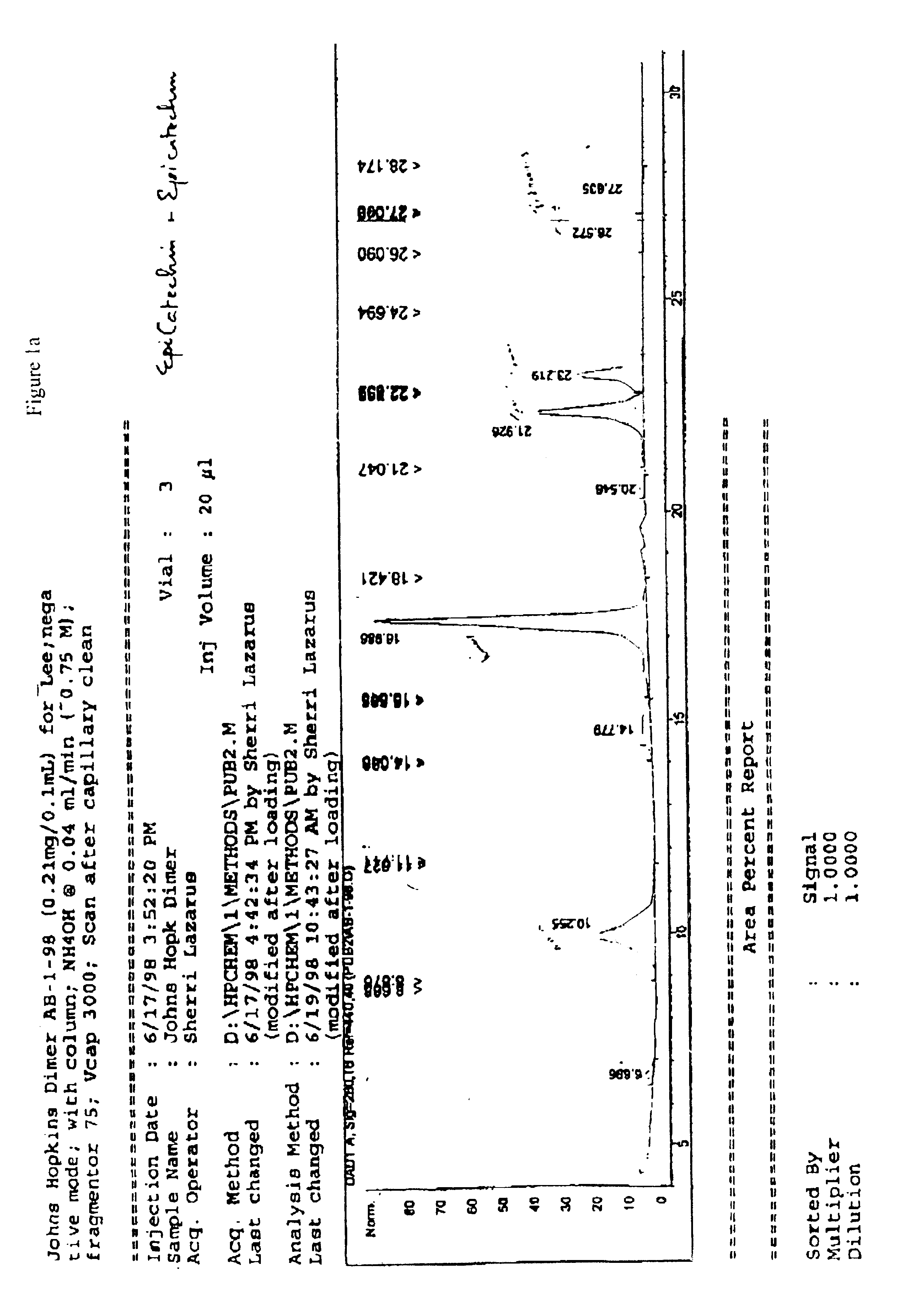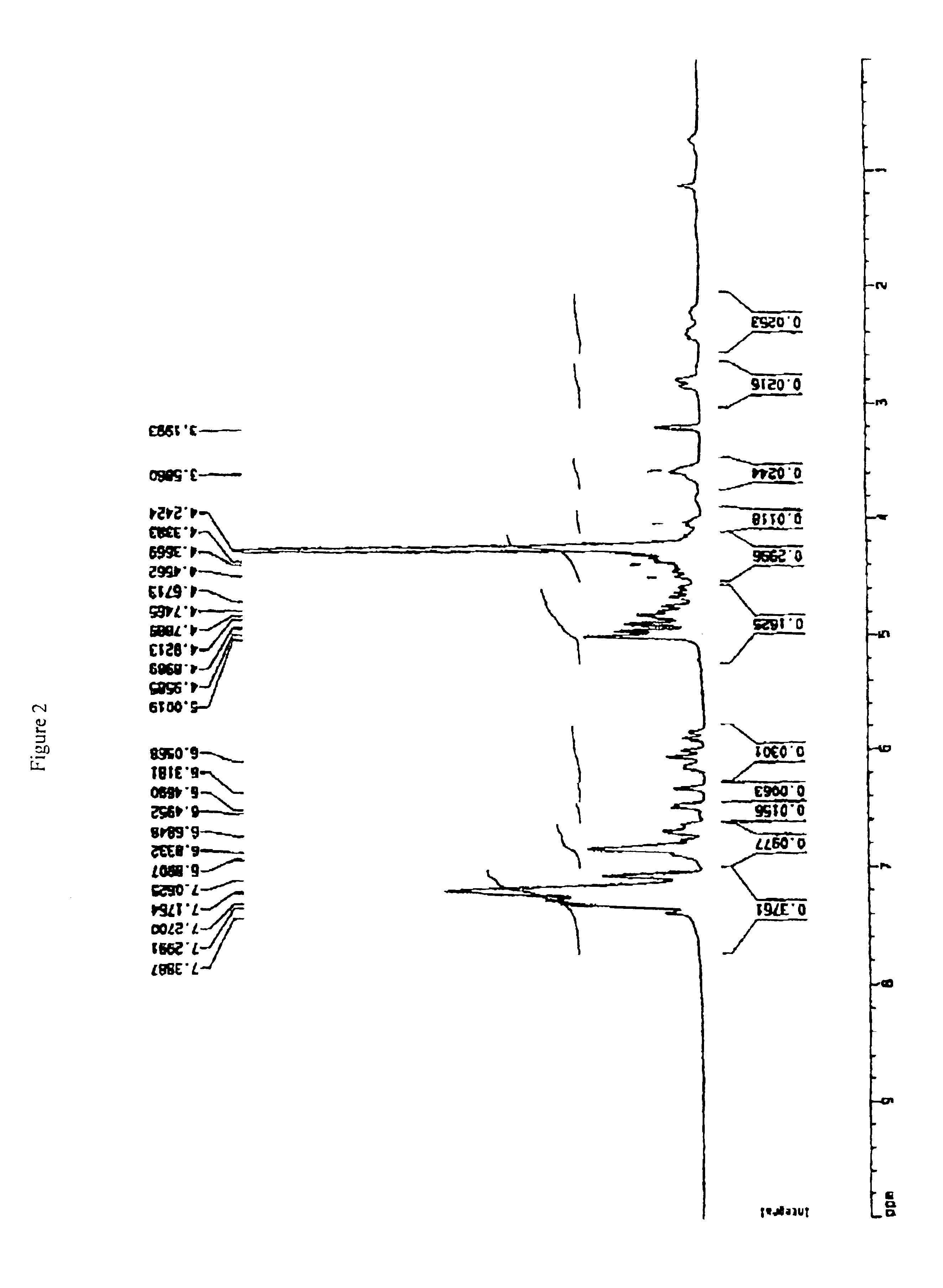Synthetic methods for preparing procyanidin oligomers
a technology of procyanidin and oligomer, which is applied in the field of synthesizing procyanidin oligomers, can solve the problems of increasing the structure complexity of the oligomer, the method is not satisfactory for obtaining sufficient quantities of the pentamer, and the time-consuming method, so as to achieve better selectivity, improve the yield, and facilitate the isolation of products
- Summary
- Abstract
- Description
- Claims
- Application Information
AI Technical Summary
Benefits of technology
Problems solved by technology
Method used
Image
Examples
examples 6-9
describe the specific conditions for the preparation of 4β-acetoxy tetra-O-benzyl-(−)-epicatechin, 4β-hydroxyl tetra-O-benzyl-(+)-catechin, 4β-hydroxyl tetra-O-benzyl-(−)-epicatechin, and 4β-acetoxy tetra-O-benzyl-(+)-catechin.
Masking Groups
The masking groups useful in this invention are electron withdrawing moieties that function to deactivate selected monomeric units of procyanidin oligomers in the electorphilic aromatic substitution coupling reaction described hereinbelow. When procyanidin oligomers are used in the coupling reaction, it is imperative that an activated monomer does not randomly react with different monomeric units of the oligomer. Masking groups are used to increase the differences in reactivity between the different monomeric units of an oligomer. Use of electron withdrawing moieties as masking groups deactivates the monomeric units of the oligomer bearing the masking groups towards coupling with an activated, protected monomer. Accordingly, in the process of thi...
example 1
Preparation of Tetra-O-benzyl-(+)-catechin
To a solution of (+)-catechin (580 mg, 2 mmol) in DMA (15 mL), benzyl bromide (960 μL, 4 eq) and K2CO3 (1.7 gm, 6 eq) were added and the mixture stirred at r.t. under argon for 48 hours. The mixture was then partitioned between ethyl acetate and water (50 mL each). The organic layer was washed with water (3×50 mL), then 50 mL saturated NaCl. Removal of the solvent gave a viscous residue from which the title compound was isolated by crystallization from 50 mL methylene chloride:methanol (9:1; v / v) to provide 880 mg of off-white crystals at a yield of 68%. 1H NMR (CDCl3) δH 7.44-7.24 (20H, m, Ar—H), 7.0 (1H, s, H-2′), 6.94 (2H, s, H-5′, H-6′), 6.25, 6.19 (2×1H, 2×d, J=2.0 Hz, H-6, H-8), 5.16 (4H, s, CH2Ph), 5.0, 4.97 (2×2H, 2×s, CH2Ph), 4.61 (1H, d, J=8.2 Hz, h-2), 3.98 (1H. m, H-3), 3.10 (1H, dd, J=16.5 Hz, H-4α), 2.63 (1H, dd, J=8.9, 16.5 Hz, H-4β).
example 2
Preparation of Tetra-O-benzyl-(−)-epicatechin
The title compound was prepared in an identical manner to that set forth in Example 1 except that (−)-epicatechin was used in place of (+)-catechin to provide 893 mg of off-white crystals at a yield of 69%. 1H NMR (CDCl3) 6H 7.43-7.30 (20H, m, Ar—H) 7.13 (1H, s, H-2′), 6.96 (2H, s, H-5′, H-6′), 6.26 (2H, m, H-6, H-8), 5.18, 5.16 (2×2H, s, CH2Ph), 5.01, 4.99 (2×2H, 2×s, CH2Ph), 4.90 (1H, s, H-2), 4.19 (1H, bm, H-3), 2.45 (2H, m, H-4), 1.64 (1H, d, J=3.8 Hz, OH).
PUM
| Property | Measurement | Unit |
|---|---|---|
| Molecular Structures | aaaaa | aaaaa |
| concentration | aaaaa | aaaaa |
| oligomeric size | aaaaa | aaaaa |
Abstract
Description
Claims
Application Information
 Login to View More
Login to View More - R&D
- Intellectual Property
- Life Sciences
- Materials
- Tech Scout
- Unparalleled Data Quality
- Higher Quality Content
- 60% Fewer Hallucinations
Browse by: Latest US Patents, China's latest patents, Technical Efficacy Thesaurus, Application Domain, Technology Topic, Popular Technical Reports.
© 2025 PatSnap. All rights reserved.Legal|Privacy policy|Modern Slavery Act Transparency Statement|Sitemap|About US| Contact US: help@patsnap.com



